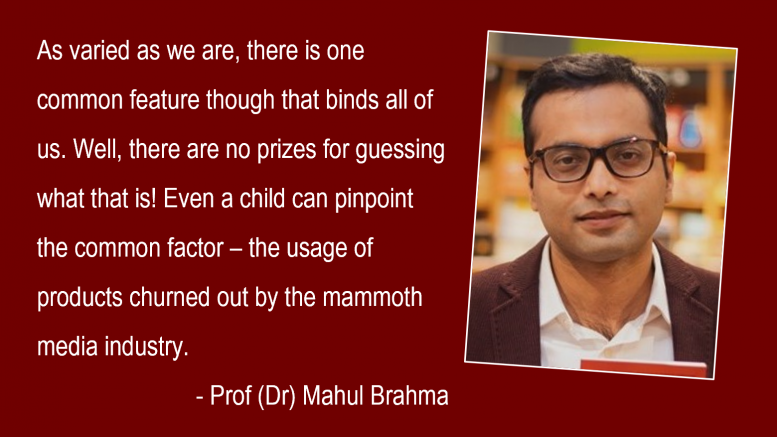Deconstructing the Larger Background
For a moment or two, let us reflect on our daily life and deconstruct the mechanism through which we usually make it worth living. An uphill task indeed considering the diversity that humanity presents. Languages, religions, ethnicities, nationalities, economic strata, and the likes – the factors that differentiate human beings are countless – not just in the figurative sense, but in the literal sense as well.
As varied as we are, there is one common feature though that binds all of us. Well, there are no prizes for guessing what that is! Even a child can pinpoint the common factor – the usage of products churned out by the mammoth media industry.
Whether we are reading a book or a printed newspaper or listening to a radio play or watching a talk show on television relishing our favourite Marvel movie at a trendy multiplex or binge-watching our favourite series on Netflix or deciding to buy a new brand of toothpaste after watching a television commercial (TVC) or deciding to donate a certain amount money for an orphan charity foundation after watching a moving campaign or going through the website of a company before buying its shares or browsing our Instagram feeds or checking an important office email – we are consciously and unconsciously consuming media products almost throughout the course of our daily existence. As inclined as some of us might be to discount the impact of media on our lives, media is there and here to stay.
The Importance of a Universal Standardised Course in Media Literacy
Naturally, media has the ingrained ability to not just influence our daily life but to alter it as well. While some of these alterations are desirable, some aren’t. Just so that we can deter the negative impact of media and make its optimum utilisation in enhancing the sheer quality of our existence, it is essential that we know it in some detail. In a hyperconnected global village, media awareness is of the essence. It wouldn’t be an overstatement if we were to say that not understanding the mediascape translates to the most dangerous contemporary illiteracy – media illiteracy.
In the given context, young adults in the age bracket of 19 years to 25 years from across the world necessarily need a compulsory course on media literacy irrespective of their chosen academic inclinations. With global consumerism and market realities almost homogenising individual choices, the curriculum for media literacy should also have some common elements. In view of the challenges posed by the ongoing pandemic and the changes brought about by the accompanying digital revolution, young adults need to be sensitized to the below-mentioned elements as parts of their media literacy curriculum:
- Misinformation, Disinformation, and Mal-Information: No, we aren’t talking about fake news, which, albeit, being a popular construct is a faulty one. With someone as blunt as Donald Trump having conceived the term in as late as 2016, we need to understand that news can’t be fake and a fake piece of information can’t be news. Hence, by default, the term fake news is an oxymoron. However, what exists today and have existed since the dawn of the concept of news are misinformation, disinformation, and mal-information. While these phenomena were there earlier as well, they have taken new avatars with the proliferation of digital and social media platforms. However, the point of this article is not to define these terms but to highlight the importance of the presence of these concepts in the curriculum for any media literacy course. Also collectively known as news disorder, young adults need to know the common ways to detect its presence in the larger news ecosystem.
- The Dynamics of Communication: Media is the means, communication is the function. Unless one understands the fundamental dynamics of how communication happens and how different media platforms change the communication paradigm, she/ he can’t be media literate.
- The Technologies of Media: With Artificial Intelligence (AI), Machine Learning (ML), and the Internet of Things (IOT) set to change the very nature of human communication, technology has become the determinant in all media discourses. Therefore, a basic understanding of the common media technologies is a sine qua non in any course of media literacy.
- The Fundamental Domains of Media: When we talk about media domains, we talk about the following large areas – journalism (both digital and analog), entertainment (film, radio, television, theater, Over-the-Top or OTT platforms, and gaming) brand communication (advertising, public relations, corporate communication, strategic communication, and digital marketing) and events and experiential marketing. For any young adult to be media literate, it is essential for her/ him to differentiate and identify these broader areas.
- Design Basics: Media content today is indistinguishable from its design. With consumers emphasising well-designed media content, it is but a given that media organisations are spending billions on packaging their products. Therefore, one has to have a basic footing in design fundamentals for her/ him to be media literate.
- Digital Privacy and Digital Security: At a time when the all-encompassing internet has penetrated our life like never before, we need to take a fresh look at digital privacy and digital security. With a significant amount of our life online and most of our assets in a digital format, young adults need to ensure how to protect their privacy and security. Thus, any course in media literacy is incomplete without including these rather critical factors.
- Digital Media and Social Media Etiquette and Ethics: With trolling and digital bullying being the worst byproducts of the current digital revolution, young adults need to be educated about the perils of unethical digital and social media behaviour. A set of ground rules need to be set and taught as a part of any course on media literacy.
- Media Sensitivity: Young adults should be taught that gender, sexuality, race, culture, language, religion, nationality, ethnicity, and the like require extreme caution. It doesn’t hurt to be respectful towards any minority or underprivileged group.
While these are the larger areas that should be compulsorily taken up, there might be regional considerations while deciding the exact curriculum for a media literacy course. However, given the dynamic nature of media, the current article shouldn’t be considered to be etched in stone.
The views and opinions published here belong to the author and do not necessarily reflect the views and opinions of the publisher.



Be the first to comment on "Media Literacy: The need for a standardised global curriculum"